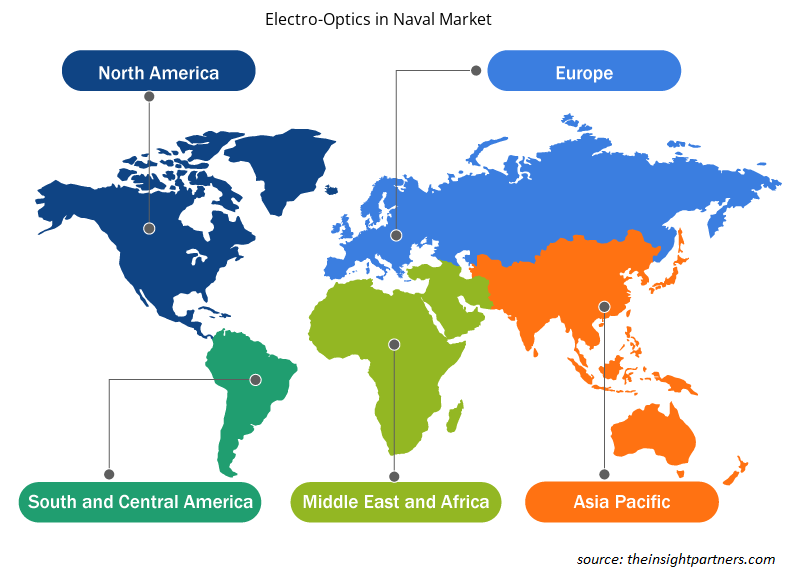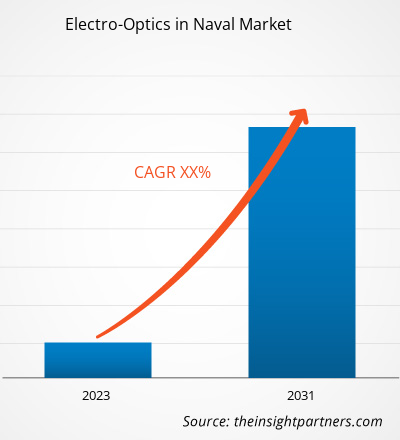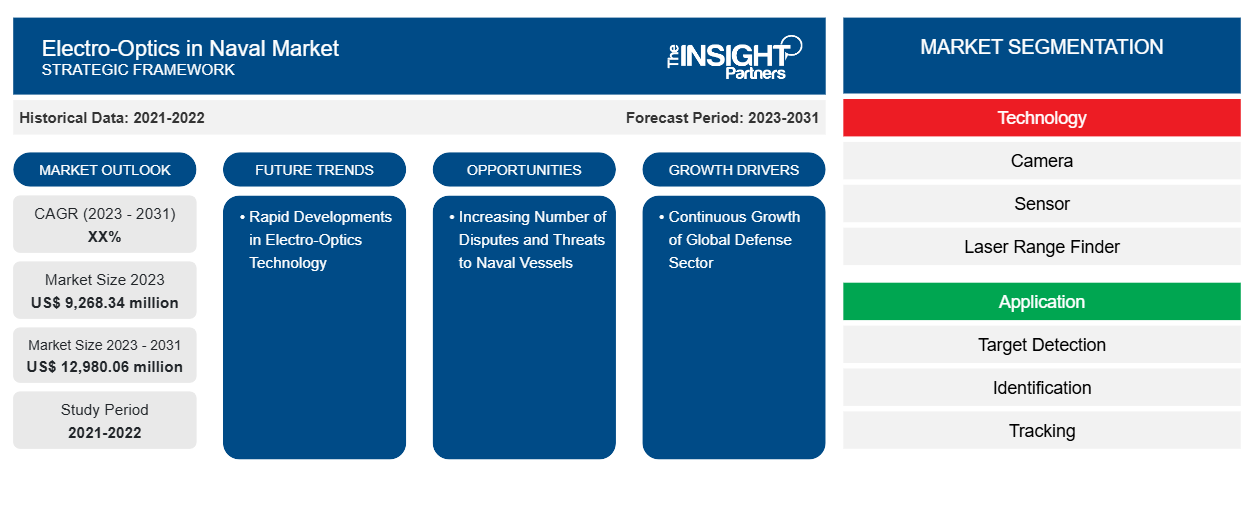Das Marktvolumen für Elektrooptik im Marinebereich soll von 9.268,34 Millionen US-Dollar im Jahr 2023 auf 12.980,06 Millionen US-Dollar im Jahr 2031 anwachsen. Elektrooptik ermöglicht eine erfolgreiche Missionsdurchführung und verfügt über einzigartige Merkmale und Fähigkeiten, die sich am besten für die Zielerfassung, Überwachung und Lageerkennung im Marinebereich eignen. Unternehmen auf dem Markt entwickeln eine elektrooptische Lösung, die überlegenen Betrieb und Überwachung in einem leichten und kostengünstigeren Paket bietet, das mehrere Missionsanforderungen für die vollumfängliche Oberflächenerkennung, Identifizierung, Überwachung und Zielbewertung effektiv unterstützt.
Elektrooptik in der Marinemarktanalyse
Mit der Marineexpansion gibt es einen Anstieg, und die nationalen Sicherheitsbedenken in Bezug auf die kommerzielle maritime Aktivität in Bezug auf Schiffsbau und Investitionen in die Hafeninfrastruktur nehmen weiter zu. Darüber hinaus zählen hohe Investitionen in die Modernisierung und Aufrüstung der elektrooptischen Technologie, ein steigender Bedarf an ISR-Fähigkeiten und die Einführung unbemannter Oberflächenfahrzeuge (USVs) zu den Hauptfaktoren, die das Wachstum der Elektrooptik im Marinemarkt vorantreiben. So erhielt L3Harris Technologies Inc. im September 2022 von der US-Marine einen Auftrag im Wert von 8,9 Millionen US-Dollar zur Lieferung elektrooptischer Sensoren für Feuerleitanwendungen für Deckgeschütze von Kriegsschiffen. Der stagnierende Lebenszyklus elektrooptischer Marinesysteme, der die Produktnachfrage nach Nachrüstinstallationen reduziert, ist jedoch einer der Hauptfaktoren, die das Marktwachstum einschränken. Im Gegenteil, die Zunahme der seegestützten Lageerkennung, ein steigender Bedarf an besseren Sensorsystemen, die für die Seepatrouille äußerst zuverlässig und genau sind, sowie schnelle Entwicklungen und F&E-Investitionen werden in den kommenden Jahren voraussichtlich lukrative Wachstumschancen für den Markt schaffen.
Marktübersicht für Elektrooptik in der Marine
Die elektrooptischen Marinesysteme bestehen aus Multisensor-Bildgebungsmodulen, die den Anforderungen für Überwachung, Beobachtung, Feuerkontrolle und Panorama-Such- und Verfolgungsfahrt gerecht werden. Darüber hinaus ermöglicht die Elektrooptik die Erkennung aller symmetrischen und asymmetrischen Bedrohungen aus der Luft und von der Oberfläche, unabhängig von Tageszeit und Wetterbedingungen. Darüber hinaus bieten elektrooptische Systeme für Sicherheitsoperationen auf hoher See und an der Küste Überwachungs-, Feuerkontroll- und Luftabwehrsysteme für verschiedene Überwasserschiffe, darunter Flugzeugträger, Fregatten , Korvetten, Hochsee- und Küstenpatrouillenboote und Hochgeschwindigkeitsfahrzeuge. Darüber hinaus sind elektrooptische Sensoren in verschiedenen Luft-, Boden- und Marineanwendungen im Einsatz und liefern Positions- und Orientierungsdaten, die für den Betrieb und die Zielerfassung erforderlich sind. Außerdem bieten die Sensoren Frühwarnung, Überwachung abnormaler Aktivitäten, Vorfallmanagement und umfassende Beobachtungs- und Reaktionsmöglichkeiten.
Passen Sie diesen Bericht Ihren Anforderungen an
Sie erhalten kostenlos individuelle Anpassungen an jedem Bericht, einschließlich Teilen dieses Berichts oder einer Analyse auf Länderebene, eines Excel-Datenpakets sowie tolle Angebote und Rabatte für Start-ups und Universitäten.
-
Holen Sie sich die wichtigsten Markttrends aus diesem Bericht.Dieses KOSTENLOSE Beispiel umfasst eine Datenanalyse von Markttrends bis hin zu Schätzungen und Prognosen.
Treiber und Chancen für den Elektrooptik-Markt in der Marine
Kontinuierliches Wachstum des globalen Verteidigungssektors
Der Wandel im modernen Kriegsführungssystem hat Regierungen auf der ganzen Welt dazu veranlasst, den jeweiligen Streitkräften hohe Mittel zuzuweisen. Die Mittelzuweisung für das Militärbudget ermöglicht es den Streitkräften, fortschrittliche Technologien und Ausrüstung von inländischen oder internationalen Herstellern zu beschaffen. In zahlreichen Ländern werden auch Soldaten und Militärfahrzeuge immer stärker modernisiert. Um die Streitkräfte mit fortschrittlichen Technologien, Waffen , Artillerie, Kampfflugzeugen, Kriegsschiffen und gepanzerten Fahrzeugen zu stärken, investieren Verteidigungskräfte auf der ganzen Welt erhebliche Beträge in die oben genannten Produkte. Der kontinuierliche Bedarf der Verteidigungskräfte an neuen Technologien für Kampf- und Nichtkampfeinsätze treibt die Verteidigungsausgaben weltweit in die Höhe.
Zunehmende Zahl von Streitigkeiten und Bedrohungen für Kriegsschiffe
Aufgrund der zunehmenden Seestreitigkeiten und Bedrohungen für Kriegsschiffe investieren die Länder in fortschrittliche elektrooptische Systeme für maritime Anwendungen wie Bedrohungserkennung, Überwachung und Zielidentifizierung. Außerdem erhöht die wachsende Zahl Territorialkonflikte und Grenzprobleme das Risiko für maritime Vermögenswerte, was zu einer zunehmenden Betonung von Überwachung, Bedrohungserkennung und Zielidentifizierung auf See führt. Darüber hinaus konzentrieren sich die Marinestreitkräfte immer mehr darauf, ihre Kriegsschiffe mit hochentwickelten und fortschrittlichen Sensorsystemen auszustatten. Zudem ist es für Kriegsschiffe wichtig geworden, bewegte Bilder von elektrooptischen Sensoren zu erhalten, die eine Tag- und Nachtsicht und eine Fernsicht auf das Ziel ermöglichen. Außerdem verbessert es die Fähigkeit des Schiffes, Ziele zu identifizieren, unterstützt den Waffeneinsatz durch automatische Verfolgung und Feuerleitlösungen durch Sichtverbindung und führt Bedrohungseinschätzungen durch. Darüber hinaus gibt es ständige Spannungen zwischen Ländern wie China-Indien, Indien-Pakistan, China-Taiwan, Russland-China und den USA-Russland. Auch die anhaltenden Konflikte zwischen Ländern wie Russland und der Ukraine, Indien und China sowie China und Taiwan sind einige der Hauptfaktoren, die die Nachfrage nach elektrooptischen Systemen in den Verteidigungsstreitkräften dieser Länder steigern. Solche Spannungen zwischen den Ländern haben den Bedarf an Marineschiffsoperationen erhöht, was wiederum die Nachfrage nach elektrooptischen Kameras, Sensoren und Laser-Entfernungsmessern in verschiedenen Regionen antreibt.
Segmentierungsanalyse des Marktberichts zur Elektrooptik im Marinebereich
Schlüsselsegmente, die zur Ableitung der Analyse des Elektrooptik-Marktes in der Marine beigetragen haben, sind Technologie, Anwendung und Endverbrauch.
- Basierend auf der Technologie ist der globale Markt für elektrooptische Marinetechnik in Kameras, Sensoren und Laser-Entfernungsmesser unterteilt. Das Kamerasegment hatte im Jahr 2023 einen größeren Marktanteil.
- Basierend auf der Anwendung ist der globale Markt für elektrooptische Marinetechnik in die Bereiche Zielerkennung, -identifizierung und -verfolgung, Überwachung, Feuerkontrolle und andere unterteilt. Darüber hinaus beschleunigt die zunehmende Tendenz zur Überwachung das Segmentwachstum mit der höchsten CAGR-Rate.
- Basierend auf der Endnutzung ist der globale Markt für elektrooptische Marinetechnik in Verteidigung und Handel unterteilt. Das Verteidigungssegment hatte im Jahr 2023 einen größeren Marktanteil.
Elektrooptik in der Marine Marktanteilsanalyse nach Geografie
Der globale Markt für Elektrooptik im Marinebereich ist in fünf große Regionen unterteilt: Nordamerika, Europa, APAC, Naher Osten und Afrika (MEA) und Südamerika (SAM). Nordamerika hatte 2021 den größten Anteil am globalen Markt für Elektrooptik im Marinebereich. Im Laufe der Jahre haben die Länder Nordamerikas einen Anstieg ihrer Militärausgaben zur Verbesserung ihrer Land-, See- und Lufttruppenfähigkeiten erlebt, was zur Einführung fortschrittlicher Technologien bei den Streitkräften führt. Im Februar 2022 vergab die US Navy einen Auftrag an Teledyne FLIR, eine Tochtergesellschaft von Teledyne Technologies, zur Wartung und Lieferung multisensorischer BRITE Star II-Bildgebungssysteme für das H-1-Programm der US Navy. Darüber hinaus werden in Marineschiffen zunehmend fortschrittliche Kamera- und Sensortechnologien für Anwendungen wie Zielerkennung, Verfolgung, Überwachung und Feuerkontrolle eingesetzt. All diese Faktoren kurbeln gemeinsam das Marktwachstum an.
Regionale Einblicke in den Elektrooptik-Markt für die Schifffahrt
Die regionalen Trends und Faktoren, die den Markt für Elektrooptik im Marinebereich während des Prognosezeitraums beeinflussen, wurden von den Analysten von Insight Partners ausführlich erläutert. In diesem Abschnitt werden auch Marktsegmente und Geografien für Elektrooptik im Marinebereich in Nordamerika, Europa, im asiatisch-pazifischen Raum, im Nahen Osten und Afrika sowie in Süd- und Mittelamerika erörtert.

- Erhalten Sie regionalspezifische Daten zum Markt für Elektrooptik im Marinebereich
Umfang des Marktberichts „Elektrooptik in der Marine“
| Berichtsattribut | Details |
|---|---|
| Marktgröße im Jahr 2023 | 9.268,34 Millionen US-Dollar |
| Marktgröße bis 2031 | 12.980,06 Millionen US-Dollar |
| Globale CAGR (2023 - 2031) | XX % |
| Historische Daten | 2021-2022 |
| Prognosezeitraum | 2023–2031 |
| Abgedeckte Segmente |
Nach Technologie
|
| Abgedeckte Regionen und Länder |
Nordamerika
|
| Marktführer und wichtige Unternehmensprofile |
|
Marktteilnehmerdichte: Der Einfluss auf die Geschäftsdynamik
Der Markt für Elektrooptik im Marinebereich wächst rasant, angetrieben durch die steigende Nachfrage der Endnutzer aufgrund von Faktoren wie sich entwickelnden Verbraucherpräferenzen, technologischen Fortschritten und einem größeren Bewusstsein für die Vorteile des Produkts. Mit steigender Nachfrage erweitern Unternehmen ihr Angebot, entwickeln Innovationen, um die Bedürfnisse der Verbraucher zu erfüllen, und nutzen neue Trends, was das Marktwachstum weiter ankurbelt.
Die Marktteilnehmerdichte bezieht sich auf die Verteilung der Firmen oder Unternehmen, die in einem bestimmten Markt oder einer bestimmten Branche tätig sind. Sie gibt an, wie viele Wettbewerber (Marktteilnehmer) in einem bestimmten Marktraum im Verhältnis zu seiner Größe oder seinem gesamten Marktwert präsent sind.
Die wichtigsten auf dem Markt für Elektrooptik im Marinebereich tätigen Unternehmen sind:
- Safran SA
- L3Harris Technologies, Inc.
- Ultra Maritime
- Tonbo Imaging
- Aselsan AS
- Elbit Systems Ltd.
Haftungsausschluss : Die oben aufgeführten Unternehmen sind nicht in einer bestimmten Reihenfolge aufgeführt.

- Überblick über die wichtigsten Akteure auf dem Markt für Elektrooptik im Marinebereich
Neuigkeiten und aktuelle Entwicklungen zum Thema Elektrooptik im Marinemarkt
Der Markt für Elektrooptik im Marinebereich wird durch die Erhebung qualitativer und quantitativer Daten nach Primär- und Sekundärforschung bewertet, die wichtige Unternehmensveröffentlichungen, Verbandsdaten und Datenbanken umfasst. Im Folgenden finden Sie eine Liste der Entwicklungen auf dem Markt für Innovationen, Geschäftserweiterungen und Strategien:
- Im November 2022 gab das Naval Undersea Warfare Center (NUWC) einen Vertrag über 173,2 Millionen US-Dollar mit SAAB zum Bau, Testen und Liefern von Drohnen bekannt, die das Verhalten und die Sensorsignatur des Feindes auswerten können. (Quelle: Naval Undersea Warfare Center, Pressemitteilung)
- Im Juni 2022 wurde ein von L3Harris Technologies (NYSE:LHX) geleitetes Team ausgewählt, um der US Navy das Shipboard Panoramic Electro-Optic/Infrared (SPEIR)-System zu liefern, das einen verbesserten Flottenschutz bieten soll. Der anfängliche Vertrag über 205 Millionen US-Dollar hat einen potenziellen Wert von 593 Millionen US-Dollar, wenn alle Optionen bis März 2031 ausgeübt werden. (Quelle: L3Harris Technologies, Pressemitteilung)
Bericht zum Markt für Elektrooptik in der Marine – Abdeckung und Ergebnisse
Der Bericht „Marktgröße und Prognose für Elektrooptik in der Marine (2021–2031)“ bietet eine detaillierte Analyse des Marktes, die die folgenden Bereiche abdeckt:
- Größe und Prognose des Marktes für Elektrooptik in der Marine auf globaler, regionaler und Länderebene für alle abgedeckten wichtigen Marktsegmente.
- Marktdynamik wie Treiber, Beschränkungen und wichtige Chancen
- Elektrooptik in der Marine – Markttrends
- Detaillierte PEST/Porters Five Forces- und SWOT-Analyse
- Analyse des Marktes für Elektrooptik in der Marine, einschließlich wichtiger Markttrends, globaler und regionaler Rahmenbedingungen, wichtiger Akteure, Vorschriften und aktueller Marktentwicklungen
- Marktlandschaft und Wettbewerbsanalyse für Elektrooptik in der Marine, einschließlich Marktkonzentration, Heatmap-Analyse, prominenten Akteuren und aktuellen Entwicklungen.
- Detaillierte Firmenprofile
- Historische Analyse (2 Jahre), Basisjahr, Prognose (7 Jahre) mit CAGR
- PEST- und SWOT-Analyse
- Marktgröße Wert/Volumen – Global, Regional, Land
- Branchen- und Wettbewerbslandschaft
- Excel-Datensatz
Aktuelle Berichte
Verwandte Berichte
Erfahrungsberichte
Grund zum Kauf
- Fundierte Entscheidungsfindung
- Marktdynamik verstehen
- Wettbewerbsanalyse
- Kundeneinblicke
- Marktprognosen
- Risikominimierung
- Strategische Planung
- Investitionsbegründung
- Identifizierung neuer Märkte
- Verbesserung von Marketingstrategien
- Steigerung der Betriebseffizienz
- Anpassung an regulatorische Trends























 Kostenlose Probe anfordern für - Elektrooptik im Marinemarkt
Kostenlose Probe anfordern für - Elektrooptik im Marinemarkt